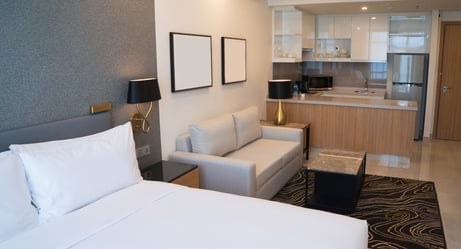Quick quiz: Which hospitality segment saw the highest occupancy rates in 2021?
Chic city hotels? Urban hotels — particularly those reliant on group travel — had 2021 occupancy rates that were lower than in 2019.
What about upscale vacation properties? Resort occupancy was around 60% and luxury occupancy was 52%, said Jan D. Freitag, National Director of Hospitality Market Analytics for CoStar Group. This represents a 12%-13% increase, respectively, over 2019.
The real winner has been extended-stay hotels, with an average occupancy rate of 73% in 2021. “Given reaccelerating business demand and continued strong leisure travel, expectations are that extended stay hotels will continue to outperform, with further occupancy and rate acceleration and continued strong investor demand,” Freitag wrote.
What’s Behind the Success of Extended-Stay Hotels?
Industry leaders point to a few different reasons. One, guests like the homelike feeling of extended-stay rooms. You can watch TV from the sofa. You can cook your own meals. You can close the bedroom door.
Also, the pullback in amenities at full-service hotels means that extended-stay doesn’t feel that different. Sure, housekeeping doesn’t come every day — but because of hotel labor shortages and COVID-altered norms, housekeeping is pared back at full-service properties, too.
Extended-stay properties are well-suited to the growing population of traveling workers, including digital nomads, who book long stays. Airbnb has reported that over the past two years, the average stay increased by 15 percent, and stays of 28 nights or longer have become the fastest-growing type of booking.
New Trends in Extended-Stay
Hoteliers are taking note. They’ve opened 444 extended-stay properties in the past two years. Many are quite different from the traditional model of cookie-cutter efficiencies.
Just look at CatBird, a boutique extended-stay hotel in Denver, Colorado. The $25 amenity fee covers perks both practical (hot breakfast, coffee, Wi-Fi, delivery lockers, gym access) and playful (the ability to borrow bikes, scooters, outdoor gear, specialized kitchen equipment, and even a houseplant for your room). Dogs are welcome for a one-time pet fee, and they receive a welcome package of their own.
In a similar spirit, Roost (which calls itself an apartment hotel instead of extended-stay) offers “rooms you actually like, in a neighborhood you want to live in, for however long you need.” Amenities include in-suite laundry, a fully equipped kitchen, Davines bath amenities, and a high-end coffee program, with Bonavita coffee makers, Baratza grinders and Chemex pour-over setups.
Then there’s stayAPT, a fast-growing brand that offers spacious, 500-square-foot-plus suites with a 55-inch television; a kitchen with full-size appliances, and a separate bedroom with a walk-in closet, TV, and workspace.
How to Win Over Extended-Stay Guests
As you can see from the latest offerings in the space, guests are beginning to expect more from extended-stay. As a result, “hoteliers will have to pay close attention to what guests want in order to maintain market share, whether it’s next-gen technology or service levels,” Hotel Management advises.
Really, guests’ wish list is simple. It includes:
- A welcome for pets — Hilton’s extended-stay properties recently became 100 percent pet-friendly, with pet fees at Homewood Suites and Home2 Suites starting at $50 per stay.
- Access to the outdoors — stayAPT recognizes guests’ heightened interest in outdoor space. Its private interior courtyard features seating, a grill and a firepit.
- A next-level kitchen — The kitchen or kitchenette is the true differentiator for extended-stay, so why not make it the best it can be? Provide kitchen equipment that guests appreciate, such as durable, powerful blenders; versatile extended-stay coffee makers; sleek toasters; and more.
Explore Hamilton Beach Commercial’s line of extended-stay hospitality products.


